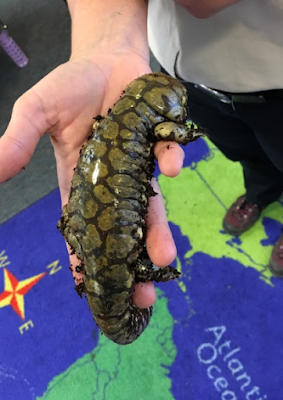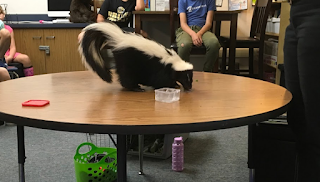As part of our animal adaptation science unit, Beverly Critcher from Wildlife Experience brought three wild animals to Mrs. Yollis' class for careful scientific observation. She brought a salamandar, a striped skunk, and a great-horned owl.
* * * * *
Wildlife Experience is a non-profit wildlife education organization that brings native and exotic animals to schools and teaches children about the importance of our natural world. Here is Ms. C., the owner of Wildlife Experiences.
* * * * *
First, we met an amphibian named Sally the Salamandar. She is called a tiger salamandar because of the stripes on her body. Amphibians can breathe on land and in water. They have lungs, but also have tiny little holes called pores, on their skin. This physical adaptation allows them to breathe underwater.
 |
| Photo by Mrs. Yollis |
One physical adaptation she has is her large mouth. She can hunt for insects easily with this adaptation. She can even eat underwater!
Sally the Salamander is twelve years old, and we got to touch her! How did her skin compare to the gopher snake?
 |
| Photo by Mrs. Yollis |
The Chinese giant salamander is the biggest salamander in the world! It can grow to be 5 1/2 feet long. Here is a photo!
* * * * *
Next we got to meet Trouble, a striped skunk. We know what you're thinking. Skunks spray up to fifteen feet! How could you have one in your classroom? The answer, Trouble's scent gland has been removed.
Here is a video of Trouble enjoying some snacks. What can you tell from her body language? Check out the teeth and claws!
How do you know if a skunk is feeling anxious? Look for body language. If his tail curves up, the skunk is afraid. If his tail is down and flat, the mammal is calm.
There are three types of skunks in North America:
- striped skunk (most common)
- spotted skunk
- hognose skunk
Skunks are omnivores, which means they eat plants and meat. Surprisingly, a skunk's favorite food is a black widow. They keep the black widow population down.
Baby skunks are quite small.
* * * * *
The final animal Ms. C. brought was a bird. Notice the glove she uses to bring out this wild animal.
The final animal Ms. C. brought was a bird. Notice the glove she uses to bring out this wild animal.
Behold! Ms. C. brought a great horned owl! These birds look like they have horns, but they are just tufts of feathers.
Here is a short video:
Look at those eyes!
We know we have great horned owls around our neighborhoods because Mrs. Yollis found this feather outside her door years ago. Look how it matches the tail feathers!
Owls have asymmetrical hearing. One ear is up and one ear is lower on his head. The ear is a hole.
The females are larger because they stay in the nest to defend.
The males are the hunters. The smaller you are, the faster you can fly, the better hunter you will be.
Owls hunt and kill with their feet, so Ms. C wears a glove. Talons, or claws, are used for grabbing and stabbing.
Owls have eyes on the front of their heads. They need the adaptation to turn the neck and see. Owls can turn their necks 2/3 of the way around!
* * * * *
What did you learn from Ms. C.?
Use World Book Online to research facts to share. Remember, do not copy and paste! That's plagiarism!









0 comments:
Post a Comment